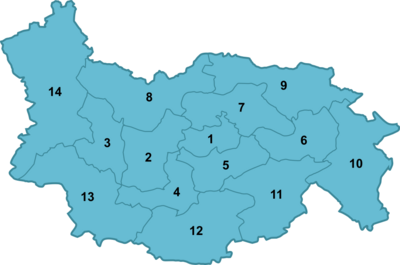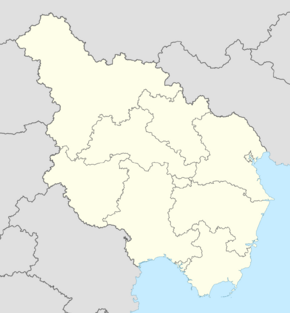Morwall
Morwall | |
|---|---|
| Greater Morwall | |
 Clockwise from top-left: Skyline of Morwall • Harrow Tower • Jarringey Court • Houses of Parliament • The Egg • City Hall | |
| Nickname(s): | |
| Country | Template:Country data Estmere |
| Constituent entity | |
| Settled as Marinium | 94 CE |
| Government | |
| • Type | Semi-parliamentary constituent entity within a federal republic |
| • Body | Greater Morwall Council |
| • Mayor | Darrell Garner (SDCP) |
| • Governing parties | SDCP |
| Area | |
| • City/Entity | 1,631 km2 (630 sq mi) |
| • Urban | 2,672 km2 (1,032 sq mi) |
| • Metro | 7,890 km2 (3,050 sq mi) |
| Population | |
| • City/Entity | 7,290,934 |
| • Rank | 1st (Estmere) 1st (Euclea) 8th (Global) |
| • Density | 4,500/km2 (12,000/sq mi) |
| • Urban | 8,789,507 |
| • Metro | 12,903,293 |
| Demonym | Morwallian |
| Time zone | UTC+0 (Euclean Standard Time) |
| Postal code(s) | |
| Official languages | |
| Website | morwall |
Morwall, officially Greater Morwall, is the capital city state of Estmere, acting as a constituent entity within Estmere comprising the metropolitan county of the same name. The state borders x to the north, y to the east, z to the south and a to the west. With an urban population of 8.7 million and a metro population of 12.9 million, Morwall is the largest city in Estmere and in Euclea as a whole. City Borough serves as the actual administrative centre.
The city itself has a long history, being founded as a fort town under the Solarian Empire. It quickly grew into a major settlement, which by the time of the Hexarchy was a prominent market town. Following the Conquest of Estmere it grew further, and emerged as a national capital. It was a major hub for the Industrial Revolution, which saw the city rapidly increase in size, becoming a major manufacturing centre for Estmere. The city was damaged heavily during the Great War and the Occupation of Estmere, and after the war the city was rebuilt extensively, becoming a centre for immigration and emerging as one of the most diverse and multicultural cities in Estmere. The federalisation of Estmere saw the city of Morwall and its surrounding environs granted significant autonomy as a constituent entity within Estmere, leading to the creation of modern day Greater Morwall. The boundaries of the state were expanded in 1984.
The city state is centred on the River Mor, and is geographically bounded by the Hitchin Hills and the Bywolds. Greater Morwall is comprised of fourteen boroughs, which are responsible for local governance within the state. The elected borough councils which lead them are similar to city councils. As a state within Estmere, Greater Morwall operates as a semi-parliamentary administration within a federal republic. Executive power is placed in the directly-elected Mayor, which has been Darrell Garner since 2014, and the Greater Morwall Council functions as the legislature.
Morwall has consistently been ranked as a first-rate city by the World City Studies Institute. Greater Morwall is an important ecomonic hub for Estmere and east Euclea, with an economy comprising world-leading financial, manufacturing and service sectors. Riverside is an important financial hub, while Redwoods is a major centre for media. The city is home to the Parliament of Estmere, Moorwood House and other government buildings. The University of Morwall is a world-leading university at the cutting edge the natural, social and applied sciences, and the state is a hub for science, technology, research and development.
Etymology and name
The city was named in the honour of Emperor Marinus, and was first known as Marinium, which was the name given to the settlement when it was first founded as a fort by the Solarian Empire. The city recieved the precursor to its current name during the time of the Hexarchy; the settlement became known by the Old Swathish name Morwealh, which derived from the term walhaz, in reference to the local Solaro-Albans who continued to inhabit the city long after the withdrawal of the Solarians. The name literally translated to "foreigners on the River Mor", referring to the major waterway on which the city is predominantly situated. After the arrival of the Verique during the Conquest of Estmere and the emergence of the modern Estmerish, the name Morwall emerged and solidified.
The official name for both the constituent entity and the metropolitan county is Greater Morwall, though both are often referred to as Morwall in passing. As the Swathish and Flurian are co-official minority languages below Estmerish in the state of Morwall, the names Morvẹll and Mèroual respectively are also sometimes used in reference to the city.
Nicknames
Morwall is known by a number of nicknames, some of which have gained official recognition and have been used in marketing by the Morwall government.
- The Heart of Estmere: refering both to the city's position at the geographical centre of the country, and to its political and economic prominence within Estmere.
- The City of the Sleepless: referring to the city's bustling night life and non-stop metro services.
- The Great Melting Pot: a reference to both the city's position at the crossroads of Estmere's Swathish and Flurian speaking populations, and the fact that the city is considered home to the Estmerish language which is derived from both. More recently, it has come to refer the wide variety of ethnicities and lanugage users in the modern city.
- The Great Wen: disparaging nickname coined in opposition to the rapid, outward growth of the city during the Industrial Revolution.
- Alikianos of the North: adopted at the foundation of the University of Morwall, intending to establish the city as a centre of knowledge in Euclea.
- The Capital of the Free World (Caput Mundi Libertas): popularised prior to the Great War and used widely during and following the Solarian War.
- Workshop of the World: in reference to the city's role in the Industrial Revolution and large manufacturing sector.
- Bee-on-the-Sea: a satirical, disparaging reference to the city's flag made by prominent vexillologist Sotirian Watson; it has since been adopted as a positive nickname for the city.
- The Hive: reference to the city's emblematic use of bees and large population.
- Gaullica's Northernmost City: disparaging nickname used by Hans Gruber, then-mayor of Wiesstadt, to criticise Anthony Restout's decision to twin with Verlois as opposed to Weisstadt.
History
Early history
Middle ages
Industrial revolution
Post-war
Modern day
Government
Greater Morwall is a constituent entity within Estmere, and Morwall is considered the capital of that entity. For most purposes, Morwall and Greater Morwall are synonymous, with Morwall having no city-wide government distinct from the government of Greater Morwall. Instead, the fourteen boroughs each have local governments closer to that of city councils.
Morwall is led by the directly-elected Mayor, which has been Darrell Garner of the SDCP since 2014. The Mayor works with the legislative Greater Morwall Council to run the city, in a semi-parliamentary system.
Geography
Boroughs
Morwall is divided into fourteen boroughs, each of which functions similar to cities elsewhere in Estmere, with an elected borough council responsible for local government. All boroughs have the prefix of borough, though the Borough of the City of Morwall has a longest prefix. All boroughs except two (Hedley and Kensworth and Shadwell and Allerton) have a single name.

|
Demographics
Ethnic groups
| 2015 Estmerish census | |
|---|---|
| Country of birth | Population |
| Template:Country data Estmere | 5,537,389 |
| 202,317 | |
| 137,608 | |
| File:RwizikuruFlag.PNG Rwizikuru | 128,959 |
| 127,190 | |
| 110,248 | |
| 93,190 | |
| File:ImaguaFlag.png Imagua and the Assimas | 89,542 |
| 83,930 | |
| 81,293 | |
Morwall is one of the most diverse cities in Estmere. According to the 2015 census, White Estmerish was the largest single ethnic group in the Morwall urban area, comprising 41.7% of the population. This figure includes Swathish and Flurian respondents. White Non-Estmerish comprised a further 13.5% of the population, with this figure predominantly including people from across the Euclean Community and from Etruria.
Black Estmerish were reported to comprise 21.3% of the population, with Estmerish Bahio-Arucians specifically comprising 9.7% of the population. The Bahio-Arucian community in Morwall has been prominent since the aftermath of the Great War, when Bahio-Arucian immigrants were invited to alleviate the city's labour shortage. Freemen also comprise a significant amount of the population.
17.8% of the population are Coian. The Coian community in Morwall is diverse, with the most prominent group being Satrians who comprise 9.7% of the population. Senrians and Xiaodongeses comprise 2.1% and 1.9% of the population respectively, with Rahelians accounting for 1.7% of the population. Dezevauni people account for 0.9% of the population, though the exact number may be higher, as the large Gowsa community numbers at least 500,000 and often does not identify as Dezevauni. Mixed race people account for 5.7% of the city's population.
The oldest continuing minority group in Morwall is the Witterite community, which arrived in the 16th century and has maintained a presence in the city since then. The Atudites and the Mirites are other prominent ethno-religious groups in the city, with most having arrived after the Great War. Foreign-born people living in Morwall are common, and the five largest foreign-born groups are those born in Padaratha, Etruria, Rwizikuru, Borland and Dezevau.
Language
Religion
Economy
Transport
Culture
International relations
Sister cities
Morwall has only two twin cities, and since 1959 the three cities have shared an exclusive arrangement where they only twin with each other. The three cities are all capitals, and are the three largest in Euclea. The sentiment is summarised in the following quote by Anthony Restout, Mayor of Morwall at the time; "For who else could be worthy of the Heart of Estmere, but the Flower of Gaullica, and the Pearl of Soravia? Who could be worthy of the Flower or the Pearl, but the Heart?"
 Samistopol, Soravia, 1959
Samistopol, Soravia, 1959Verlois, Gaullica, 1959
Other relationships
In the 1980s Morwall began to explore relationships outside of the exclusive twinning relationship. Morwall maintains agreements of friendship and cooperation with a number of other cities.
 Keisi, Senria, 1981
Keisi, Senria, 1981 Newstead, Borland, 1984
Newstead, Borland, 1984 Tyrrenhus, Etruria, 1986
Tyrrenhus, Etruria, 1986 Precea, Paretia, 1988
Precea, Paretia, 1988 Adunis, Tsabara, 1988
Adunis, Tsabara, 1988 Spálgleann, Caldia, 1991
Spálgleann, Caldia, 1991 Yndyk, Alsland, 1991
Yndyk, Alsland, 1991 Aalmsted, Azmara, 1991
Aalmsted, Azmara, 1991- File:ImaguaFlag.png Cuanstad, Imagua, 2006



